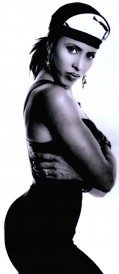BY DAVE STEINFELD
Curve
Most people remember Nona Hendryx as one-third of the groundbreaking group LaBelle. During the girl group era of the early ’60s, that trio began as a quartet, Patti LaBelle and the Bluebelles, and included LaBelle, Hendryx, Sarah Dash, and Cindy Birdsong. The fact that they were largely unsuccessful was no indication of what their next phase would be like. By the dawn of the 1970s, Cindy Birdsong was one of the Supremes, and the remaining trio had undergone a serious makeover, both in sound and style. In their new incarnation–as LaBelle–the tame lyrics and matching dresses were out, replaced by a musical mix of glam rock and R&B, and outfits that featured everything from wild feathers to space suits, à la George Clinton. They released half a dozen albums and scored a No. 1 hit in 1974 with the classic “Lady Marmalade,” about a New Orleans prostitute.
Hendryx has never been one to shy away from addressing controversial topics. Indeed, she’s had to overcome more obstacles than most people during her four-plus decades in music. Not many black women (let alone openly bisexual, Buddhist black women) were making rock ’n’ roll in the 1970s. “There were very few people,” she confirms. “Betty Davis was a contemporary. She was a little more into the funk side, and she was married to Miles. She was very interesting. But I’m trying to think of who else there was at the time. Chaka [Khan]–but she wasn’t doing more of the political [stuff], and she was the female singer in a male band. It was difficult. But that’s one of the things about youth. When you’re younger, you almost have blinders on.”
Read more at Curve
Curve, the nation’s best-selling lesbian magazine, spotlights all that is fresh, funny, exciting, controversial and cutting-edge in our community.







